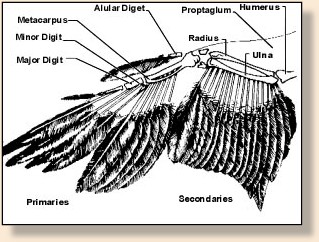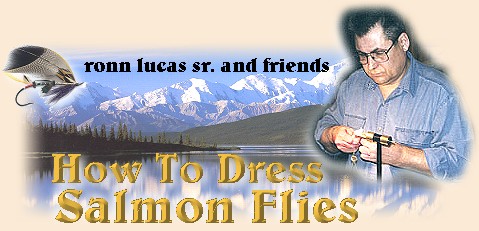Skinning Birds
You may have already tried skinning or, after you have
gone off the deep end with your tying, you may encounter
deceased feather or, fur producers. Since this series
really focuses more on feathers than fur, I will give
the steps I take to skin birds. If you want my steps for
fur bearers, e mail me and, I'll be glad to give them to
you.
It takes me about ½ hour to skin a bird like a Pheasant.
You can certainly rip a skin off a bird much faster than
that but, when I remove the skin every feather the bird
grew is still attached to the skin and, the very few that
fall off are put in a numbered bag that follows the
numbered skin.

My "system" for skinning Pheasants/birds is as follows.
While you are doing all of this it's important not to open
the body or sever blood vessels and to keep the feathers
from touching fluids during the skinning. I use surgical
scissors that have dull points. Make an incision just under
the lower beak where the feathers end. Insert the scissors
under the skin and cut straight down the neck and keel short
of the vent. Separate the skin from the meat carefully and
work your hands around the body and neck as far as possible.
Note, while I am skinning a bird, I dust a little Borax
on the skin as I go. This dries the moisture and eliminates
any ruined feathers. Now, cut around the face at the feather
line to the top beak. Lift the neck and peal the skin as far
forward to the beak as you can and then cut the skull off of
the beak with heavy scissors. Now hold the neck and work it
away from the skin down the back as far past the wings as you
can. This is the tricky part. Pull the skin down one of the
wings like pulling off a glove, carefully working the skin
off the wing as far as you can without tearing the skin. Cut
the wing bone and, do the other side. Again holding the neck,
pull the body off the skin to the legs and do the same as you
did to the wings. I leave the feet on and you can pull the
leg inside out to the knee where you cut the bone. There is
no meat in the feet so there is nothing to rot. Now, pull the
skin to the tail and go as far as you can without tearing the
skin. Cut the tail off and, that's about it. All you really
need to do is spread the skin out on news paper or other
absorbent material to get rid of most of the moisture. You
can either leave the skin on the paper to completely dry or,
as I do, I use a hair dryer right after the bird has been
skinned rather than leaving it to dry naturally. It only
takes 5 or 10 minutes to dry the skin enough to handle it
easier. Also, since I am trying to preserve the natural
shape of the head, I stuff a paper towel in there after
the hair dryer treatment. I also put some salt on the inside
of the tail and stuff a towel into the area to absorb moisture.
You could also do it in the legs and wings too but, I haven't.
After the skin is dry or, mostly dry, turn the skin feather
side up, turn the wings over and make a cut the length of the
ulna and radius where there will be a little meat left. Open
this up and remove some of the meat. I don't worry about
getting it all out at this stage, it will be easier when
it has cured and dried a bit. Then put a little pile of salt
on the exposed meat. You can leave it this way until it
completely dries. I don't do anything else to preserve
the skins. In about a week the wings and feet will be dry.
If the skin has any blood or dirt on it you can wash it
at this stage and, dry it with a hair dryer. If you feel
the need, spray the skin with an insect killer.
Note: I've recently done the wings a little differently
and, it seems to be a better way that leaves the wing flexible
so selection of feathers is easier. When peeling the skin off
the body and wing, continue to strip the skin off the ulna
and radius. This will require more work by forcefully separating
the feather anchors that seem attached to the bone itself.
This eliminates 90% of all the meat in the wing and makes
a cleaner skin. When I grade a skin #1 that I have processed,
it is the finest example of a skin and, most complete that
you are likely to find anywhere.
There is a book called From Field to Fly by
Scott Seymour, published by Frank Amato Publications that
gives a pretty good overview of skinning birds and mammals.
You can see a review of it here.
Happy Trails! Ronn Lucas, Sr. ~ rlucas@cybcon.com
Back to Index
|



